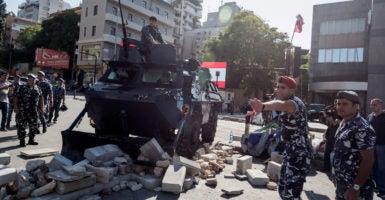What started out as spontaneous protests Oct. 17 opposing a tax imposed on a popular messaging service escalated into the largest political protests in Lebanon since the 2005 “Cedar Revolution” and forced the resignation Tuesday of Prime Minister Saad al-Hariri.
Hariri’s action is unlikely to end the protests, which have drawn a quarter of the country’s 4 million citizens into the streets to demand the resignation of government leaders, an exit of the political elite, and a new government system.
The massive anti-government protests represent a widespread rejection of an entrenched and corrupt political oligarchy that has failed to deliver adequate basic services, including electricity, potable water, garbage collection, health services, and public transportation.
The influx of more than 950,000 Syrian refugees into Lebanon further strained government services.
Lebanon’s power-sharing system rewards sectarian political parties and awards them Cabinet positions that the parties often use to siphon off state resources.
The state-run electricity sector receives $2 billion of government subsidies each year, but is unable to provide electricity on a reliable basis. Most of Lebanon experiences daily power outages.
The state-dominated telecommunications industry charges customers notoriously high prices. Local phone calls in Lebanon are five times more expensive than local calls in Jordan and 20 times more expensive than in Egypt.
No wonder that imposing the new tax on messaging applications ignited protests by long-suffering Lebanese citizens.
Corruption and Mismanagement
Corruption allegations have motivated many recent anti-government protests in Algeria, Egypt, and Sudan, but the Lebanese protests most closely resemble the ongoing protests in Iraq.
For the past month, tens of thousands of young Iraqis have staged protests against high unemployment, corruption, and inadequate government services. As in Lebanon, the protests increasingly have assumed an anti-Iranian tint as political factions supported by Iran have opposed the protesters’ demands and attacked protesters.
As a result, a strong popular backlash has erupted against Iranian influence. But unlike Iraq, Lebanon has little oil wealth that could be used to fund government reforms.
Lebanon is facing enormous domestic challenges. Its economy and trade routes have been disrupted by the ongoing war in neighboring Syria. In addition to high unemployment and slow economic growth—projected to be 2% in 2019—Lebanon’s national debt has surged to $86 billion, more than 150% of its gross domestic product, one of the highest debt ratios in the world.
Merely servicing the debt consumes about 45% of government revenues, which has motivated official efforts to find new sources of tax revenue.
Protests have remained secular in nature, with Christian, Shiite, and Sunni protesters waving the Lebanese flag and chanting anti-government slogans such as “All of them means all of them,” and calling out political elites who have fueled sectarian tensions for their own benefit.
Demonstrations spread across cities in northern Lebanon, Beirut, as well as Hezbollah southern strongholds, including Tyre and Nabatieh. Surprisingly, southern protesters chanted anti-Hezbollah rhetoric even after Hassan Nasrallah, the leader of Hezbollah, warned against forcing the resignation of the government elite.
Nasrallah said protesters need to “let this government continue but with a new spirit and a new way of working … [learning] its lesson from the last two days of popular outburst.”
Hezbollah supporters also have tried to disrupt the protests. In a viral video posted on social media, the Lebanese army was seen blocking motorcyclists bearing flags of Hezbollah and Amal, an allied Shiite party, from entering protest squares in the capital city of Beirut.
The respite was short-lived, though, as Hezbollah and Amal members later attacked protesters in Beirut. Lebanon remains on edge and could rapidly descend into widespread political violence if political tensions are not eased soon.
No Clear Way Forward
In an effort to calm protests, Hariri announced a series of cost-cutting reforms Oct. 21, promising a reduction of government salaries, a reformed electricity sector, and downsizing and/or cutting of obsolete government institutions such as the Ministry of Information.
But the protesters rejected the concessions as being too little too late, and Hariri was forced to resign.
Lebanese President Michel Aoun, who is aligned with Hezbollah, may decide not to accept Hariri’s resignation, just as he did in November 2017, when Hariri resigned under pressure from Saudi Arabia.
But if accepted, Hariri’s resignation will prompt negotiations over the appointment of a new prime minister and a reshuffling of the coalition government. It is doubtful, however, that any deal negotiated by Lebanon’s discredited leaders will satisfy the protesters, who have demanded that the government be run by technocrats who are not beholden to sectarian political parties widely regarded as corrupt.
Regardless, the wave of protests across the Middle East underscore the increasing disconnect between political elites and the citizens they are supposed to represent.
Like most of the Arab world, Lebanon’s young people are better educated and more demanding than their parents: 40% of those under 25 have reached the highest levels of the nation’s education system, but the unemployment rate is 37% for those 35 and under.
Recognizing the crippling effects of sectarianism, young protesters in the Middle East have rejected such agendas and echoed similar demands: economic opportunity, the purging of corruption, and a systemic overhaul of political systems. Self-interested and unaccountable political parties, the protesters argue, have failed time and time again to address legitimate popular grievances.































